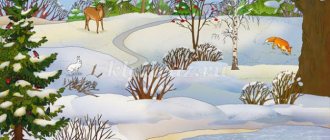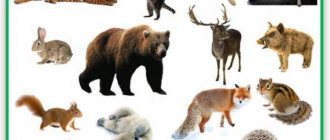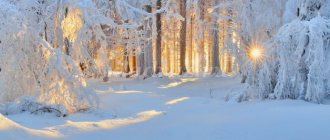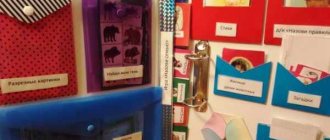Junior group. Early childhood, nursery. Children 1-4 years old
Summary of OS on speech development in the early age group “Wild Animals” “ Wild Animals ”
Goal: speech development of young children.
Objectives: Educational: - teach to recognize and name wild animals - hare , wolf, bear, fox; - learn to imitate the movements and sounds made by animals .
Developmental: - develop children’s speech activity;... Lesson summary on the topic “Wild Animals” (junior group) Topic: “ Wild Animals ”. Age: junior group Purpose: To improve children's verbal communication in creative and play situations. Integration of educational areas: Objectives: Speech development To form intonation expressiveness of speech; Be able to make generalizations, the simplest...
Summary of educational activities in the second junior group “Wild Animals”
Summary of educational activities in the second junior group “Wild Animals”
Goal: consolidating the knowledge of younger
preschool age about
wild animals
, their cubs, and place of residence.
Tasks:
— consolidate children’s knowledge about wild animals
;
- develop the ability to distinguish between animals and their young
, correctly correlate their names;
— broaden their horizons and activate children’s vocabulary by introducing them to new animals
;
- cultivate a sense of love for the surrounding world, caring attitude towards the inhabitants of wildlife
;
Preliminary work:
Reading fiction: “The Fox and the Hare”, arr. V. Dalia, A. Blok “Bunny”, I. Tokmakova “Bear”.
Conversations about wild animals
Making riddles.
Review of didactic material and book illustrations.
D\i games “Whose kids”, “Whose tail” board games: “Dominoes”.
P/i “At the bear in the forest”, “Who lives where?” and etc.
Progress of the lesson:
Bring a toy bear into the group; he has an envelope with pictures of animals. Invite the bear to sit in class and listen to how the children study. The envelope contains riddles about each animal. Read the riddles and, as soon as the children guess, invite them to choose a picture depicting the desired animal.
Gray in summer, white in winter.
(Hare).
Fluffy tail, golden fur, lives in the forest, steals chickens in the village.
(Fox).
Who wanders in the forest angry and hungry in the cold winter?
(Wolf).
He sleeps in a den in winter under a huge pine tree, and when spring comes, he wakes up from sleep.
(Bear).
Educator: Well done, guys! All the riddles were solved. Tell me, who are all these riddles about? (About
wild animals )
Educator: That's right, all these animals are wild
. Why do you think they are called that?
Children: Because these animals live in the forest
, take care of themselves, get their own food.
Educator: Guys, let's play a game. Come to this table (on the table on one side there is a model of a house, on the other there are trees)
.
wild animals
in my hands .
Only they are all mixed up and I can’t understand where the wild ones are
and where the domestic
animals are
.
You need to arrange the pictures into 2 piles. Where do wild animals live
?
Nice, in the forest. So we will put pictures with their images on the trees. Where do pets
?
That's right, next to the person. we will put
pictures with pets , next to the house.
Educator: Guys, while we were playing with you, our animals from the forest got their children mixed up. Let's help little animals find their mother. Didactic game “Help the cub find his mother”
.
The bear has a teddy bear.
The wolf has a wolf cub.
The hare has a bunny.
The squirrel has a baby squirrel.
Educator: What great fellows you are! All the cubs were returned to their mothers.
Guys, little animals want to thank you and play with you.
Educator: Let's put forest animals in our houses?
Finger gymnastics:
A bunny jumps across the lawn ( Clench your hands into fists, and raise your index and middle fingers up
- “bunny”).
Jump - hop, jump - hop ( Clench your hands into fists, “bunny” - alternate movements)
The bunny was scared of the wolf ( Press your hands to your chest)
And he took off running. ( Open your palms, stretch your arms in front of you)
D/i “Find the house” (children draw a line to the house of the fox, squirrel, bear).
Game “Come on, bunny walk”
Come on, bunny, come out! We perform inviting movements with our right hand
Come on, white man, come out! We perform inviting movements with our left hand
Bunny, bunny, dance,
Come on, white one, dance! Hands on the belt, dancing, we turn to the left, then to the right
Clap your hands
Stomp your feet
And spin a little
Bow to all of us. We carry out movements according to the content of the text
Lesson summary
:
Who did we talk about today? Why do we call them wild
?
Well done! Today you guessed all the riddles correctly and answered the questions.







